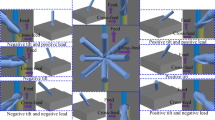Abstract
Five-axis milling makes it possible to control the relative pose between a tool and surface normal of a workpiece, and is widely used in manufacturing. In this study, an experimental investigation of the application of parameter inversion for residual stress adjustment in five-axis milling has been conducted based on two methods: an orthogonal experiment with interaction of factors and a random setting of the expected residual stress. The results of the orthogonal experiment with interactions of factors show that the significance of the influence of the machining parameters on the residual stress obtained with parameter inversion is similar to the experimental results. The results of the experiment with a random setting of the expected residual stress show that the average of the difference between the measured and expected results for the 30 cutting conditions is only 0.3951 MPa, which indicates that residual stress prediction using parameter inversion is statistically effective. Moreover, the results show that using parameter inversion, the correctness of the prediction of compressive and tensile residual stress is 73.33%, which is higher than the 50% value that is achievable without any adjustment. Overall, the results of the experimental investigation in this paper show that residual stress adjustment based on parameter inversion is applicable for five-axis milling, which shows the potential of this adjustment method for industrial applications.





Similar content being viewed by others
References
Ghosh S, Rana VPS, Kain V, Mittal V, Baveja SK (2011) Role of residual stresses induced by industrial fabrication on stress corrosion cracking susceptibility of austenitic stainless steel. Mater Des 32(7):3823–3831. https://doi.org/10.1016/j.matdes.2011.03.012
Lazoglu I, Ulutan D, Alaca BE, Engin S, Kaftanoglu B (2008) An enhanced analytical model for residual stress prediction in machining. CIRP Ann - Manuf Technol 57(1):81–84. https://doi.org/10.1016/j.cirp.2008.03.060
Ulutan D, Lazoglu I, Dinc C (2009) Three-dimensional temperature predictions in machining processes using finite difference method. J Mater Process Technol 209(2):1111–1121. https://doi.org/10.1016/j.jmatprotec.2008.03.020
M’Saoubi R, Chandrasekaran H (2011) Experimental study and modelling of tool temperature distribution in orthogonal cutting of AISI 316L and AISI 3115 steels. Int J Adv Manuf Technol 56(9-12):865–877. https://doi.org/10.1007/s00170-011-3257-y
Huang K, Yang W, Chen Q, He S (2016) An experimental investigation of temperature distribution in workpiece machined surface layer in turning. Int J Adv Manuf Technol 85(5):1207–1215. https://doi.org/10.1007/s00170-015-8016-z
Komanduri R, Hou ZB (2000) Thermal modeling of the metal cutting process: part I—temperature rise distribution due to shear plane heat source. Int J Mech Sci 42(9):1715–1752. https://doi.org/10.1016/S0020-7403(99)00070-3
Huang K, Yang W (2016) Analytical model of temperature field in workpiece machined surface layer in orthogonal cutting. J Mater Process Technol 229:375–389. https://doi.org/10.1016/j.jmatprotec.2015.07.008
Huang K, Yang W, Chen Q (2015) Analytical model of stress field in workpiece machined surface layer in orthogonal cutting. Int J Mech Sci 103:127–140. https://doi.org/10.1016/j.ijmecsci.2015.08.020
Huang K, Yang W (2016) Analytical modeling of residual stress formation in workpiece material due to cutting. Int J Mech Sci 114:21–34. https://doi.org/10.1016/j.ijmecsci.2016.04.018
Huang K, Yang W (2017) Analytical analysis of the mechanism of effects of machining parameter and tool parameter on residual stress based on multivariable decoupling method. Int J Mech Sci 128-129:659–679. https://doi.org/10.1016/j.ijmecsci.2017.05.031
Chen W, Vanboven G, Rogge R (2007) The role of residual stress in neutral pH stress corrosion cracking of pipeline steels – part II: crack dormancy. Acta Mater 55(1):43–53. https://doi.org/10.1016/j.actamat.2006.07.021
Withers PJ (2007) Residual stress and its role in failure. Rep Prog Phys 70(12):2211–2264. https://doi.org/10.1088/0034-4885/70/12/r04
Arrazola PJ, Özel T, Umbrello D, Davies M, Jawahir IS (2013) Recent advances in modelling of metal machining processes. CIRP Ann - Manuf Technol 62(2):695–718. https://doi.org/10.1016/j.cirp.2013.05.006
Brinksmeier E, Gläbe R, Klocke F, Lucca DA (2011) Process signatures – an alternative approach to predicting functional workpiece properties. Procedia Eng 19:44–52. https://doi.org/10.1016/j.proeng.2011.11.078
Brinksmeier E, Klocke F, Lucca DA, Sölter J, Meyer D (2014) Process signatures – a new approach to solve the inverse surface integrity problem in machining processes. Procedia CIRP 13:429–434. https://doi.org/10.1016/j.procir.2014.04.073
Huang K, Yang W, Ye X (2018) Adjustment of machining-induced residual stress based on parameter inversion. Int J Mech Sci 135:43–52. https://doi.org/10.1016/j.ijmecsci.2017.11.014
Jin H, Yang W, Yan L (2012) Development of an improved energy-based method for residual stress assessment. Philos Mag 92(4):480–499. https://doi.org/10.1080/14786435.2011.616867
He W, Xue W, Tang B (2017) Optimization test design method and data analysis. Chemical Industry Press, Beijing
Acknowledgments
This work is supported by the Major State Basic Research Development Program of China (973 Program, Grant No. 2014CB046704). Special thanks to the Advanced Manufacturing and Technology Experiment Center (in the School of Mechanical Science and Engineering, Huazhong University of Science and Technology) and the Analysis and Testing Center of Huazhong University of Science and Technology for their help.
Author information
Authors and Affiliations
Corresponding authors
Additional information
Publisher’s note
Springer Nature remains neutral with regard to jurisdictional claims in published maps and institutional affiliations.
Rights and permissions
About this article
Cite this article
Huang, K., Yang, W., Gao, Y. et al. Experimental investigation of the application of parameter inversion for residual stress adjustment in five-axis milling using an annular cutter. Int J Adv Manuf Technol 105, 3233–3247 (2019). https://doi.org/10.1007/s00170-019-04431-5
Received:
Accepted:
Published:
Issue Date:
DOI: https://doi.org/10.1007/s00170-019-04431-5



